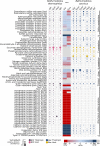Comparative proteomics of related symbiotic mussel species reveals high variability of host-symbiont interactions
- PMID: 31680119
- PMCID: PMC6976577
- DOI: 10.1038/s41396-019-0517-6
Comparative proteomics of related symbiotic mussel species reveals high variability of host-symbiont interactions
Abstract
Deep-sea Bathymodiolus mussels and their chemoautotrophic symbionts are well-studied representatives of mutualistic host-microbe associations. However, how host-symbiont interactions vary on the molecular level between related host and symbiont species remains unclear. Therefore, we compared the host and symbiont metaproteomes of Pacific B. thermophilus, hosting a thiotrophic symbiont, and Atlantic B. azoricus, containing two symbionts, a thiotroph and a methanotroph. We identified common strategies of metabolic support between hosts and symbionts, such as the oxidation of sulfide by the host, which provides a thiosulfate reservoir for the thiotrophic symbionts, and a cycling mechanism that could supply the host with symbiont-derived amino acids. However, expression levels of these processes differed substantially between both symbioses. Backed up by genomic comparisons, our results furthermore revealed an exceptionally large repertoire of attachment-related proteins in the B. thermophilus symbiont. These findings imply that host-microbe interactions can be quite variable, even between closely related systems.
Conflict of interest statement
The authors declare that they have no conflict of interest.
Figures



References
-
- Dubilier N, Bergin C, Lott C. Symbiotic diversity in marine animals: the art of harnessing chemosynthesis. Nat Rev Microbiol. 2008;6:725–40. - PubMed
-
- Duperron S, Bergin C, Zielinski F, Blazejak A, Pernthaler A, McKiness ZP, et al. A dual symbiosis shared by two mussel species, Bathymodiolus azoricus and Bathymodiolus puteoserpentis (Bivalvia: Mytilidae), from hydrothermal vents along the northern Mid-Atlantic Ridge. Environ Microbiol. 2006;8:1441–7. - PubMed

